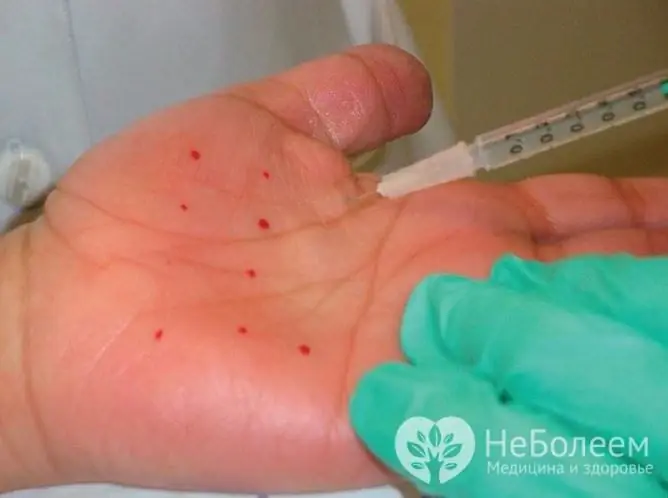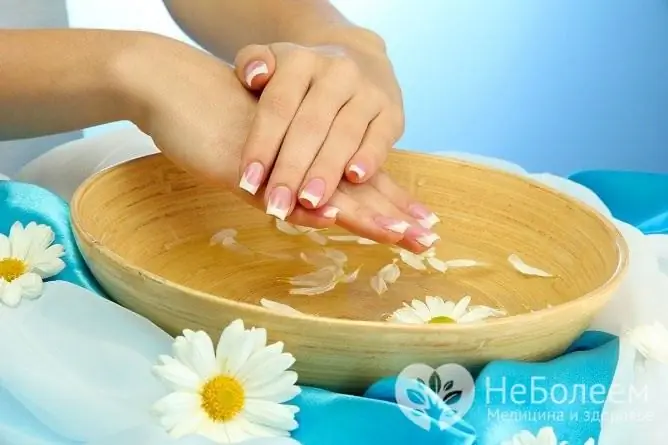- Author Rachel Wainwright [email protected].
- Public 2023-12-15 07:39.
- Last modified 2025-11-02 20:14.
Hyperhidrosis of the palms: causes of hand sweating, symptoms and treatment
The content of the article:
- Why does palmar hyperhidrosis develop?
-
Types of hyperhidrosis of the palms
Characteristics of pathology in terms of severity
- Disease symptoms
-
Hand sweating treatment
- Antiperspirant use
- Botulinum therapy
- Iontophoresis
- Traditional medicine
- Neurosurgical sympathectomy
- Video
Hyperhidrosis of the palms (palmar hyperhidrosis) is the process of increased sweating associated with impaired functioning of the eccrine sweat glands located in the skin of the palmar surfaces of the hands.

Increased sweating of the hands is associated with a malfunction of the sweat glands
Constantly wet and cold hands are the main manifestations of pathology. Such symptoms disrupt the patient's social interaction with the people around him, and in severe cases of the disease, they can interfere with the mastery of a number of professional skills (working with a computer, jewelry, small objects, and others).
If symptoms characteristic of the disease appear, you should seek the advice of a dermatologist. The prognosis of the primary form of palmar hyperhidrosis is not very encouraging. Full recovery cannot be achieved in patients with this diagnosis. All methods of therapy are aimed at reducing local manifestations to normalize the labor and social spheres of a person.
Why does palmar hyperhidrosis develop?
The functioning of the sweat glands is influenced by both external and internal factors. Reliable determination of the cause of palms sweating gives the doctor the opportunity to choose the most adequate and effective treatment, as well as prevent relapse. Through symptomatic therapy, you can get rid of hyperhidrosis for life if its etiology has not been established.
The factors that serve the appearance of pathology include:
- genetic predisposition;
- dysfunction of nerve centers;
- hormonal imbalance;
- dermatological diseases.

Stress can lead to increased symptoms of illness
Intensification of symptoms is most often observed with stress, regular eating of garlic, spices, onions and other irritants, as well as when staying in an environment with high air temperatures. The influence of these factors is especially clearly monitored in patients whose perspiration in a calm state does not abnormal.
Types of hyperhidrosis of the palms
Along with increased sweating of the feet, armpits and face, the palmar form refers to the local manifestations of the pathological process. There are the following types of hyperhidrosis for etiological reasons:
| Name | Characteristic |
| Primary (idiopathic, or essential) | Its appearance is associated with a genetic predisposition, therefore the first signs of the disease are recorded even in infancy. It is manifested by an increase in the number of sweat glands by 1 unit. skin area, as well as an increase in their reactivity in response to nerve impulses of normal strength. Factors contributing to a steady increase in sweating include trauma, severe pathologies, severe emotional upheaval and hormonal imbalances |
| Secondary |
It is a consequence of a number of pathologies of neurological and somatic genesis. For example, Raynaud's syndrome, diseases of the endocrine glands, polyneuropathy, as well as dysfunction of the thermoregulatory center in syringomyelia, erythromelalgia, and vegetative-vascular dystonia. Sweating occurs only in adults and decreases to normal during remission of the underlying disease |
An important role for the selection of adequate therapy is not only the establishment of the type of disease, but also the severity of its manifestations. The main criterion for this is the amount of sweat secreted by the skin.
Characteristics of pathology in terms of severity
If the patient's palms are slightly moist, in general his condition is not much different from that of healthy people. An increased release of fluid is noted only with strong emotional upheavals, and therefore does not particularly affect daily activities, ability to work and adaptation in society.

Hyperhidrosis of the palms complicates social communication
When, against the background of the disease, the hands are constantly cold and damp, it is often necessary to use a handkerchief or towel. The patient has difficulty shaking hands, working with small objects or paper.
Patients whose hands are constantly cold with drops of sweat face great difficulties. When you touch objects, wet traces remain on them or they become slippery, which does not allow you to engage in a number of professions. Often, this severity of pathology is accompanied by the development of depression, leading to isolation from society.
The extreme severity of the disease is when the hands are cold and sweat flows down profusely. This condition does not threaten death, but sharply reduces the quality of life of patients. Their social adaptation, as well as professional implementation, is extremely complicated.
Disease symptoms
You can suspect pathology by the following signs:
- hands cold and damp;
- increased sweating, the amount of which varies depending on the severity of the disease; this process completely stops during sleep and is activated only during wakefulness;
- noticeable pinkness of the skin of the upper limbs;
- deepening of lines and furrows on the palms.
Hand sweating treatment
To select an effective method of therapy, the patient should consult a dermatologist. Usually, the beginning of treatment consists of using the simplest and most affordable means. In extreme cases, when no methods help to reduce sweat secretion, they resort to surgical intervention - neurosurgical sympathectomy.
Antiperspirant use
With a moderate degree of severity, hygienic or medical antiperspirants can be used, the active substance of which is aluminum hexachlorohydrate. This method is contraindicated only if there are abrasions or cuts on the surface of the palms.

For mild symptoms, the use of hygienic or medical antiperspirants is sufficient.
In cases of severe hyperhidrosis, antiperspirants are ineffective, since constantly protruding and flowing sweat does not allow the active ingredient to penetrate the pores of the skin.
Botulinum therapy
Botulinum therapy is another way to combat sweating. For its implementation, botulinum toxin type A is used, which is injected into the affected area by injection. The effect of one such procedure can last for six months.

In some cases, botulinum therapy is indicated.
This method of treatment has only one drawback - the high cost of an injection drug, and an average of 120 units of the drug are used per procedure.
Iontophoresis
The simplest, most affordable and effective method of therapy is iontophoresis. It refers to physiotherapy procedures carried out both in medical institutions and at home with the necessary equipment.
Traditional medicine
Traditional medicine recommends vinegar baths for problems with hand sweating. In 500 ml of hot boiled water pour 5 teaspoons of apple cider vinegar, mix. Hands are immersed in the liquid up to the wrist for 15-20 minutes, then, without rinsing, it is easily wiped with a dry cloth.

Baths can be used to treat hand sweating.
It is recommended to do such procedures daily for 7-14 days.
Neurosurgical sympathectomy
If none of the methods are successful, the patient may be offered neurosurgical sympathectomy. During it, nerve fibers are clipped or crossed, through which impulses pass to the sweat glands located on the palms. The skin of the patient's hands immediately after the operation becomes dry and warm.
Before making a decision on surgical intervention, the patient should consider its possible negative consequences. Horner's syndrome acts as a complication of the operation. With it, damage to the lung tissue occurs with the development of pneumothorax, as well as motor nerves with impaired mobility of the upper limbs.
This reaction can be so pronounced that it becomes necessary to carry out repeated intervention in order to remove the clips from the nerve trunks of the hands.
Hyperhidrosis of the palms is a medical condition that affects the daily life of the patient and limits his professional capabilities. A qualified specialist should decide how to treat pathology, taking into account the causative factor and the severity of the manifestations.
Video
We offer for viewing a video on the topic of the article.

Anna Kozlova Medical journalist About the author
Education: Rostov State Medical University, specialty "General Medicine".
Found a mistake in the text? Select it and press Ctrl + Enter.






